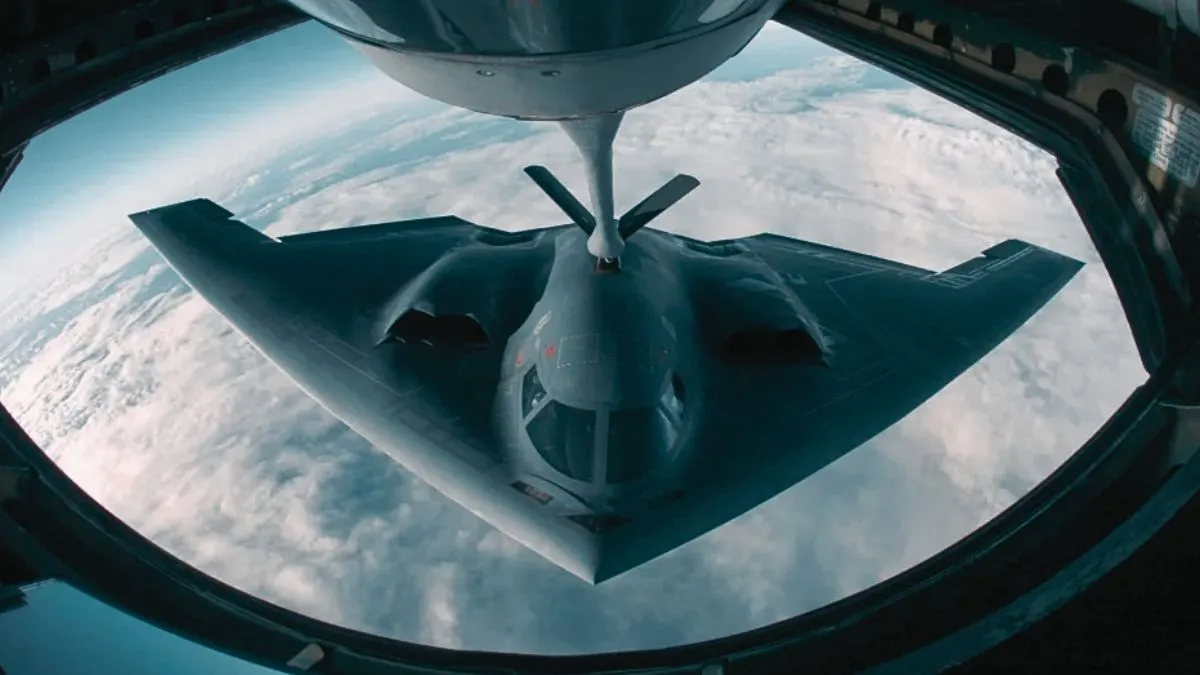- By Supratik Das
- Mon, 25 Aug 2025 02:01 PM (IST)
- Source:JND
The B-2 Spirit, America’s most expensive stealth bomber, has long been praised as a key part of US air power. Developed by Northrop Grumman in great secrecy during the Cold War, this USD 2 billion flying wing can carry nuclear weapons, travel over 11,000 kilometers without refueling, and hit heavily fortified targets with precise accuracy. Yet, for all its technological brilliance, the B-2 has one surprising weakness, and that is rain.
Why B-2 Bomber Can't Tolerate Rain?
The bomber's smooth surface is covered with radar-absorbent material (RAM), a special paint intended to scatter hostile radar signals and keep the aircraft virtually invisible. But this coating is extremely susceptible to dampness. Rainfall over an extended period can peel, bubble, or lose its stealth capability, rendering the plane visible. Engineers cannot just "waterproof" the jet without sacrificing its invisibility, for even slight modifications to the RAM surface would change its radar signature.
In contrast to the majority of fighter aircraft or bombers that may be parked openly on airstrips, the B-2 Spirit requires enormous climate-controlled hangars. These types of facilities control temperature and humidity to avoid water damage to sensitive stealth surfaces and avionics. It costs millions of dollars annually to keep such specialised hangars available worldwide and has been characterised by US officials as one of the most costly logistical challenges in contemporary aviation. Each B-2 mission involves a significant amount of ground work upon landing. Crews take hours reviewing for water seepage into seams, ducts, and sensors. The US Air Force has admitted that the bomber is so fragile that it takes more time on the ground to preserve its stealth capability than it does to fly missions. A 1997 US Congress report had already cautioned that "contact with water or moisture can harm some of the low-observable enhancing surfaces of the airplane" and that the issue might never be completely resolved in spite of advances in materials.
The Spirit Of Kansas Crash
The B-2's susceptibility to water was most tragically demonstrated on Feb. 23, 2008, when the "Spirit of Kansas" bomber crashed at Andersen Air Base in Guam. The plane had been left outside overnight during a deluge. Further investigation revealed that rainwater entered a key sensor and caused faulty avionics. Because the B-2 is dependent on computer-aided fly-by-wire flight controls, the breakdown resulted in its crash shortly after takeoff. Pilots ejected safely, but one of them had a serious spinal injury. The USD 2 billion bomber was lost in the blaze, one of the most expensive mishaps in US aviation history.
ALSO READ: Indian Engineer Helped Design B-2 Stealth Bomber: But Why Noshir Gowadia Ended Up In US Prison
Ironically, one of the most deadly machines in the world can't survive something as ordinary as rain. That's why operations with the B-2 are carefully scheduled on the basis of weather forecasts, as even light rain can compromise high-stakes missions. To counter this, the US Air Force operates a global chain of specialised shelters just to accommodate the small fleet of 20 surviving planes. Netizens commonly refer to this as a "billion-dollar parking problem," which illustrates the contradiction of a bomber that rules the skies but dreads the rain.
ALSO READ: What Are B-2 Stealth Bombers? Is US Preparing To Hit Iran's Nuclear Sites With 30,000-Pound GBU-57?
In spite of its vulnerability, the B-2 Spirit is still a pillar of US strategic deterrence. It is the sole long-range bomber in the American inventory that can penetrate advanced air defense systems and carry nuclear bombs deep within enemy lines. In June 2025, the US used seven B-2 stealth bombers to conduct a surprise attack on Iran's fortified nuclear sites, dropping 14 GBU-57 Massive Ordnance Penetrator bombs to disable them. This highlights their ongoing presence in Washington's defense policy. The new B-21 Raider, built by Northrop Grumman as well, is likely to include lessons from the B-2, such as stronger stealth coatings and lower maintenance costs. But meanwhile, the B-2 is still both a technological marvel and an example of how excessive complexity can render even the most advanced machines susceptible to nature's most basic forces.

